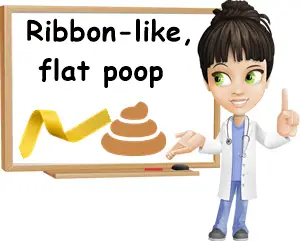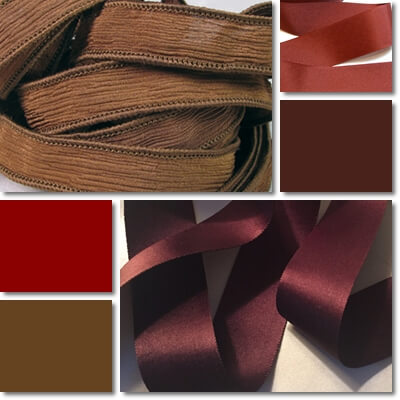Flat ribbon stools are a type of abnormal bowel movement, meaning a bowel movement whose appearance is atypical. A lot of times, this is just another way of describing thin and narrow bowel movements, such as stringy or pencil-like stools. Depending on whether such stools occur frequently or infrequently (occasionally), a pathology may or may not exist. Understanding the underlying cause is the first step towards receiving adequate treatment and resuming normal life, with a return to normal-looking bowel movements.
What do normal stools look like?
There is such a thing as an ideal stool appearance: ideally, stools should be well-formed, as bulky as, say, a banana, soft in consistency, smooth and without cracks on the surface, and passed daily. As for color and smell, a medium to darker shade of brown and a tolerable odor are considered characteristics of normal stools.
However, there is some variation to what normal stools should look like. Temporary changes in color due to dietary factors (eating spinach, red beets, watermelon, tomatoes, cocoa), variations in bulkiness due to higher or lower fiber or food intakes, different consistencies as a result of dehydration, dietary changes such as a preference for one food group over another, anatomical differences and more factors directly affect bowel movement appearance. Learn more about what are normal bowel movements like.

What are Flat ribbon stool?
Flat ribbon like stool are an unusual or abnormal type of bowel movement. They are characterized as being significantly thinner than normal and flat or somehow compressed, hence the association with ribbons which are thin, narrow bands of fabric. Color, odor or consistency may be in the normal range or not, depending on the underlying cause and other symptoms may or may not be present alongside the particular appearance. Often times, flat, ribbon-like stools are another way of describing thin and narrow, stringy or pencil-like bowel movements – also atypical in appearance.
Flat Ribbon Stool Causes
Plenty of people have likely experienced flat ribbon stools once or even a few times during their lifetime. Given they are so unusual-looking and rather striking in appearance compared to how normal bowel movements look, they no doubt draw attention and make us wonder why they’ve occurred.
Believe it or not, not all flat stools are caused by cancer. Because that’s the first thought they evoke in the average person’s mind. Keeping an eye on the situation to see if it’s a one-time thing or occurs repeatedly, observing if there are any other symptoms as well as seeing a doctor for advice, tests or answers are the top three things to do if you ever pass this type of bowel movement.
Next up, find out what having a flat ribbon poop means.

Eating too little
Stools are not normally flat. But sometimes you can pass a slimmer or less consistent bowel movement that may take on a thinner or narrower shape if you’ve eaten very little over the past several days. Because your transit has completed and that was all there was to pass.
After all, stools are about 2/3 water and only about 1/3 leftover food and fiber material, bacteria, mucus, fat, cells etc. If you’ve eaten more plant foods which are naturally high in water (a lot of fruits are around 90% water), but haven’t eaten very much overall, chances are your stools are softer, more malleable and can thus come out stringy, thin, pencil-like or even flat.
Too much fiber
Dietary fiber is indigestible plant material that doesn’t get absorbed or assimilated like nutrients from food, so it comes out pretty much as it came in. There are two types of fiber: insoluble and soluble.
Insoluble fiber does not dissolve in water, but adds bulk to stools. Soluble fiber dissolves in water, becoming gel-like, so it helps soften stools. Eating more fiber than you normally do can hurry transit time beyond normal parameters and result in soft, blobby, loose or mushy, very thin stools that can look stringy or flat.
In the worst of cases, diarrhea occurs. If this is what is causing occasional flat, ribbon-like stools, you should be able to tell by recalling what you ate in the past few days (and comparing to your normal dietary habits) and other symptoms such as flatulence, cramps or urgency to have a bowel movement.
Temporary preference for one food group
A lot of people go through phases when it comes to their diet. If you happen, for example, to eat a lot of plant foods over the course of several days, especially fresh fruits and some vegetables, and this is not a normal dietary choice for you, you may get too much fiber and possibly experience very thin, soft stools due to the fiber expediting transit.
Gastrointestinal infections
Bacterial or viral gastroenteritis or any kind of gastrointestinal infection is likely to cause loose, watery stools and diarrhea, sometimes with the presence of blood. In some people, the infection can cause thin, flat, pencil or ribbon-like stools. In addition to the change in bowel movement appearance being temporary, other symptoms such as nausea, vomiting and fever should help identify the cause as an infection.
Intestinal parasites
Parasitic worms are notorious to cause the most diverse of symptoms and the most resilient of infections. Often times they go unnoticed and can increase in numbers to the point they cause blockages along the gastrointestinal tract. Sometimes, these blockages can result in flat, ribbon or pencil-like stools. Stool testing and, sometimes blood testing, can help identify the exact parasite and identify an efficient course of treatment.
Hemorrhoids
Obstruction due to hemorrhoids is possible and can result in thin, flat, ribbon-like stools. If the hemorrhoids are swollen and acting up, but you’ve been careful to eat plenty of fiber and drink plenty of liquids to soften stools and make their passing easier, it’s not impossible to experience really soft, but reduced-caliber bowel movements that may come out looking pencil or ribbon-like.
Other symptoms of hemorrhoids include light bleeding, pink or bright red, itching, swelling, pain after bowel movements and pain that gets worse with sitting. See what foods to eat and to avoid for hemorrhoids.
Irritable Bowel Syndrome
Sometimes, having the occasional flat stool may mean you have a bowel condition such as IBS, or irritable bowel syndrome. Common symptoms of IBS include: altered bowel movements, either frequent constipation or diarrhea, or constipation alternating with diarrhea, intolerance to certain foods causing flatulence and bloating, loose stools and diarrhea, painful abdominal cramps, urgency to have a bowel movement, feelings of incomplete evacuation after a bowel movement and mucus in stools.
While it’s not clear why IBS would cause one to have flat poop, it apparently happens. Treatment includes restricting fermentable carbohydrates (FOODMAP diet) for reduced periods of time and symptomatic treatment of diarrhea and constipation.
Other bowel diseases
Celiac disease, colitis, Crohn’s disease, Crohn’s colitis and any inflammatory bowel disease can cause altered bowel movements that could occasionally result in flat, ribbon-like stools. However, this form of bowel movement is not specific to such conditions and therefore should be an infrequent occurrence at most.
Polyps or cancer
What causes flat ribbon-like stools in some people are obstructions of the intestinal tract. These may be non-cancerous polyps, benign tumors or cancers. Changes in bowel movement appearance and habits and other symptoms to look out for: frequent thin, narrow, pencil or ribbon-like stools, red or red-tinged or black, coffee grounds-like stools, presence of blood, unintentional, but significant weight loss, constant abdominal pain or lower back pain or pain with bowel movements, anemia, tiredness and fatigue. If you experience symptoms like this, it’s important to see your doctor for tests as soon as you can.
Conclusion
Flat ribbon stools are not always a sign of cancer. That is, if you’ve had a flat ribbon-like stool once, but then resumed normal bowel movement appearance, chances are it’s not cancer. Still, if it happens again, it’s best to see a doctor and together find out what is causing it.
It’s good to remember that what constitutes normal stool appearance for one person may not for another, so there is some variation with regards to bowel movement appearance. Still, because bowel movement appearance is an excellent indicator of gastrointestinal health, any changes in color, consistency, odor and especially shape and size warrant our attention and should be reported to our healthcare provider if they occur frequently. As for flat ribbon stools, they don’t occur in normal circumstances, or in generally healthy people which means it’s good to keep an eye on them.
